

Express 12.12 - Disciplinary Literacy: A Shift That Makes Sense. Express 12.12 - Strategies for Teaching Complex Texts. Educational Leadership:Literacy in Every Classroom:How Knowledge Powers Reading. Strategies to Help Students ‘Go Deep’ When Reading Digitally. Students are doing more reading on digital devices than they ever have before.

Not only are many teachers using tablets and computers for classroom instruction, but many state tests are now administered on computers, adding incentive for teachers to teach digital reading strategies. But casual digital reading on the internet has instilled bad habits in many students, making it difficult for them to engage deeply with digital text in the same way they do when reading materials printed on paper. Devin Hess sympathizes with educators’ concerns, but believes digital reading is here to stay and teachers have a duty to equip students to engage with digital texts in meaningful ways. Hess was a middle school social studies teacher and early tech adopter in his classroom. Now he works with the UC Berkeley History-Social Science Project training social studies teachers on deep reading strategies.
“I don’t believe technology should ever be taught separately,” Hess said. Teaching Nonfiction Reading Skills in the Science Classroom [ACTIVITY] Posted by Bill Ferriter on Monday, 05/20/2013 I don't have a ton of time to write today -- I've spent the past week teaching and learning alongside of some really progressive thinkers in Australia -- so I figured I'd share a few handouts that I've been using in class this year to teach nonfiction reading skills in my sixth grade science classroom.
![Teaching Nonfiction Reading Skills in the Science Classroom [ACTIVITY]](http://cdn.pearltrees.com/s/pic/th/teaching-nonfiction-classroom-58588283)
Text Complexity: Simplifying Text Complexity And The Common Core. Modeling Close Reading for Future Teachers: ELA Videos and Webinars. In my previous post, I shared how I use freely available video in my reading and literacy methods course to help my preservice teachers (PTs) understand close reading instruction at a level that could not be attained through reading and discussion alone.
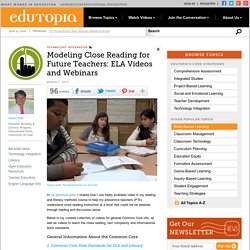
Below is my curated collection of videos for general Common Core info, as well as videos to teach the close reading, text complexity and informational texts standards. General Information About the Common Core 1. Common Core State Standards for ELA and Literacy This 15-minute video gives a general overview of the CCSS and explains why the U.S. has moved to the Common Core. 2. This is a set of cartoon drawings that explain the different organizations and institutions involved in developing the CCSS. 3. This eight-minute video provides an opportunity for teacher educators to hear from the two individuals who are most responsible for the CCSS -- David Coleman and Sue Pimentel.
Close Reading 4. In this three-minute video, Dr. 5. 6. 7. 8. 9. Digital Reading Poses Learning Challenges for Students - Education Week. Published Online: May 6, 2014 Published in Print: May 7, 2014, as Screen Reading Poses Learning Challenges Comprehension may suffer when students read on the digital devices now flooding into classrooms, an emerging body of research suggests.
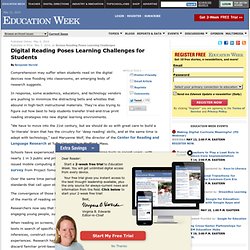
In response, some academics, educators, and technology vendors are pushing to minimize the distracting bells and whistles that abound in high-tech instructional materials. They're also trying to figure out how best to help students transfer tried-and-true print reading strategies into new digital learning environments. "We have to move into the 21st century, but we should do so with great care to build a 'bi-literate' brain that has the circuitry for 'deep reading' skills, and at the same time is adept with technology," said Maryanne Wolf, the director of the Center for Reading and Language Research at Tufts University in Medford, Mass. Digital Reading Tension Christopher Hitt, 14, is the picture of a "reluctant reader. " "I never read. But Mr. Understanding Language. In the first lesson in this unit, students are introduced to the use of persuasion in visual, print, and multimodal advertisements.
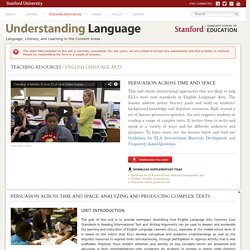
Many advertisements, particularly video, embed persuasive techniques in the familiar genre of narrative first to inform, engage, and interest readers and viewers emotionally, and then to persuade them to take some form of action. This action may be to buy a product, sign a petition, attend an event, or change their behavior. Sometimes the purpose is to raise awareness of an issue –the action or response required is not always made explicit. This lesson explores how the use of persuasive techniques within the narrative of advertisements accomplishes these goals. Students are introduced to a number of textual analysis standards and persuasive techniques that will be developed and deepened throughout the unit. Express 9.13 - Teaching Students to Read like Historians. Teaching Students to Read like Historians Deni Basaraba, Gina Biancarosa, Sarah Carlson, and Lina Shanley Research indicates a significant gap between what it means to read like a historian and the way students typically read historical texts (Shanahan, 2012).
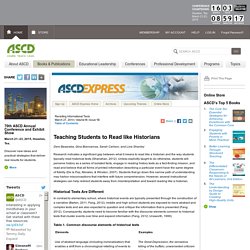
Unless explicitly taught to do otherwise, students will perceive history as a series of isolated facts, engage in reading history texts as a fact-finding mission, and read and believe that all forms of printed information describing a particular event have the same degree of fidelity (De la Paz, Morales, & Winston, 2007). Students that go down this narrow path of understanding may harbor misconceptions that interfere with future comprehension. However, several instructional strategies can help redirect students away from misinterpretation and toward reading like a historian. Historical Texts Are Different Table 1. Source information across multiple documents. Creating Cross-Curricular Text Sets for the Middle Grades.
By Amanda Wall A text set is a group of texts that share a common theme.
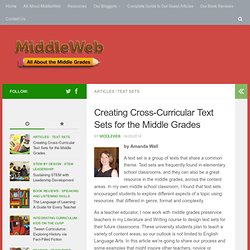
Text sets are frequently found in elementary school classrooms, and they can also be a great resource in the middle grades, across the content areas. Literacy Design Collaborative.